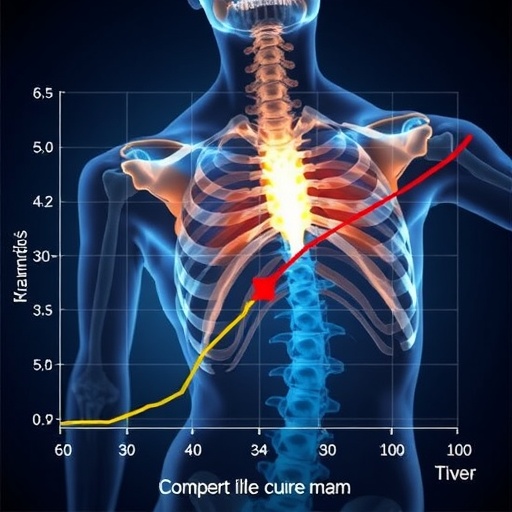In a groundbreaking development in the field of biomedical engineering and vehicular safety, researchers have focused on a specific and often overlooked aspect of crash dynamics—lap belt-induced iliac wing fractures, particularly among female populations. This research initiative, spearheaded by K. Somasundaram, N. Yoganandan, and F. Pintar, has resulted in the formulation of a comprehensive risk curve aimed at better understanding the injury mechanisms and enhancing safety standards for female occupants involved in frontal sled tests. This innovative study sheds light on how conventional lap belt designs can influence injury risk and the gender-specific vulnerabilities that arise from such designs.
At its core, the study investigates how lap belts, an essential component of automotive safety systems, can inadvertently contribute to serious injuries, particularly iliac wing fractures. While seat belts have significantly reduced mortality rates in vehicular accidents, the study emphasizes a growing concern regarding the biomechanics of these restraints. The researchers meticulously harnessed data from frontal sled tests using female post-mortem human subjects (PMHS) to understand the nuances of how lap belts interact with the anatomy of female occupants.
This research underscores a critical challenge in the automotive safety design both for manufacturers and regulatory bodies. The iliac wing, located at the top of the pelvis, is particularly susceptible to fractures during frontal impacts when loads are transferred through the lap belt. Preliminary findings indicate that the geometry of women’s pelvises plays a crucial role in the variance of injury patterns compared to their male counterparts. These differences necessitate a tailored approach to safety design rather than a one-size-fits-all methodology.
The intricacies of this study extend into exploring the mechanics of how forces are distributed during a crash. By simulating frontal impacts, Somasundaram and his team quantified the stress and strain experienced by different anatomical structures. The formulation of the iliac wing fracture risk curve is not merely a theoretical exercise; it offers actionable data for automotive engineers to reconsider their safety protocols and design frameworks.
The risk curve assists in identifying thresholds beyond which the likelihood of sustaining an iliac wing fracture increases significantly. This data is pivotal for regulatory bodies aiming to enforce more rigorous safety standards, particularly for vehicles that may have historically neglected the anatomical differences in their crash test dummies. What’s commendable about this research is its potential impact on policy changes concerning vehicle safety standards—policies that can save lives by shifting the paradigm towards a more inclusive design philosophy.
Moreover, the concerted push for integrating female-specific data into automotive safety has garnered attention from various stakeholders, including automotive manufacturers and safety advocacy groups. By highlighting the disproportionate risk faced by female occupants, researchers are not only saving lives but also promoting a broader conversation about gender equality in protection standards.
While this research is critical, it also opens the door to further inquiries about other potential injury mechanisms among female occupants. For instance, a multidisciplinary approach may lead to studies on the impacts of various seat designs, actuation of airbags, and even the interplay of driver and passenger safety systems. There exists an opportunity for collaboration between engineers, ergonomists, and clinicians to develop a holistic understanding of occupant safety.
The implications of this research extend beyond just the realm of car crashes. As societal awareness grows regarding women’s safety in various contexts, including transportation, the need for gender-informed design principles across all safety-oriented systems becomes ever more crucial. Each study like this paves the way for a future where safety designs are inherently inclusive, eliminating the disparity seen today.
In summation, the pioneering work by Somasundaram, Yoganandan, and Pintar on lap belt-induced iliac wing fractures not only charts a promising path for future automotive safety enhancements but also warrants immediate attention from both industry and regulatory stakeholders. The time has come for the automotive industry to evolve beyond conventional safety parameters and embrace gender-specific considerations in their designs, placing an emphasis on informing and shaping public safety policies based on scientific evidence.
Through their focused research inquiry, these scholars illuminate the intricacies of crash dynamics and serve as a catalyst for future studies dedicated to enhancing occupant safety for diverse populations. Their focus on gender in biomechanical research invites further discourse and elevates the industry’s commitment to equitable safety standards. As we stand on the brink of innovation driven by evidence-based design strategies, we can anticipate a future where the risks associated with vehicle safety are significantly mitigated, ultimately leading to safer roadways for everyone.
Thus, the message is clear: improving safety for female vehicle occupants is not just an academic concern; it represents a profound ethical responsibility that must be embraced by manufacturers and lawmakers alike.
Subject of Research: Lap belt-induced iliac wing fractures among female occupants during frontal impacts.
Article Title: Lap belt-induced Iliac Wing Fracture Risk Curve Development for Female PMHS in Frontal Sled Tests.
Article References:
Somasundaram, K., Yoganandan, N. & Pintar, F. Lap belt-induced Iliac Wing Fracture Risk Curve Development for Female PMHS in Frontal Sled Tests.
Ann Biomed Eng (2025). https://doi.org/10.1007/s10439-025-03830-y
Image Credits: AI Generated
DOI:
Keywords: Automotive safety, iliac wing fractures, lap belts, female PMHS, crash dynamics, biomechanics, gender-specific safety, risk curve development.
Tags: automotive design challengesbiomechanics of seat beltsbiomedical engineering in crash dynamicsfemale automotive safetyfrontal sled test researchgender-specific injury vulnerabilitiesiliac wing fracture riskinjury prevention in womenlap belt injury mechanismspost-mortem human subjects studysafety regulations for seat beltsvehicular safety standards





